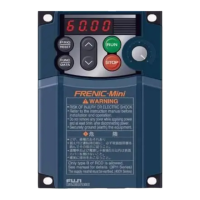6-9
6.3 If an Alarm Code Appears on the LED Monitor
[ 1 ]
0c
n Overcurrent protection
Problem The inverter output current momentarily exceeded the overcurrent level.
0c1
Overcurrent occurred during acceleration.
0c2
Overcurrent occurred during deceleration.
0c3
Overcurrent occurred when running at a constant speed.
Possible Causes What to Check and Suggested Measures
(1) The inverter output
terminals were
short-circuited.
Remove the wires connected to the inverter output terminals
(U, V, and W) and measure the interphase resistance. Check i
the resistance is too low.
Î Remove the part that short-circuited (including replacement
of the wires, relay terminals and motor).
(2) Ground faults occurred at
the inverter output
terminals.
Remove the wires connected to the inverter output terminals
(U, V, and W) and perform a Megger test.
Î Remove the part that short-circuited (including replacement
of the wires, relay terminals and motor).
Measure the motor current with a measuring device, and to
trace the current trend. Therefore, use this information to judge
if the trend is over the calculated load value for your system
design.
ÎIf the load is too heavy, decrease it or raise the inverte
capacity.
(3) Loads were too heavy.
Trace the current trend and check if there are any sudden
changes in the current.
Î If there are any sudden changes, make the load variation
smaller or raise the inverter capacity.
Î Enable instantaneous overcurrent limiting (H12 = 1).
(4) The value set for torque
boost (F09) was too large.
(F37 = 0, 1, 3, or 4)
Check that the output current decreases and the motor does
not come to stall if you set a lower value than the current one
for F09.
Î Lower the value for torque boost (F09) if the motor is not
going to stall.
(5) The acceleration/
deceleration time was too
short.
Check that the motor generates enough torque required during
acceleration/deceleration. That torque is calculated from the
moment of inertia for the load and the acceleration
deceleration time.
Î Increase the acceleration/deceleration time (F07, F08, E10,
E11, and H54).
Î Enable current limiting (F43).
Î Raise the inverter capacity.
(6) Malfunction caused by
noise
Check if noise control measures are appropriate (e.g., correct
grounding and routing of control and main circuit wires).
Î Implement noise control measures. For details, refer to
"Appendix A" of the FRENIC-Mini User’s Manual (MEH446).
Î Enable the retry function (H04).

